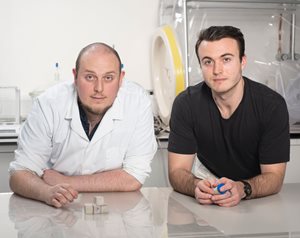Carbon negative cement
Replacing cementitious materials with a carbon-negative alternative could enable carbon neutral concrete – without making any changes to the construction process

In the autumn of 2020, two PhD students from Imperial College London were in a South Kensington pub, talking about concrete. Sam Draper (above left), studying cementitious substitutes, wanted to know: could the silica that Barney Shanks had produced as part of his research into magnesium-based cements be used to make a carbon-neutral cement mix?
“We couldn’t see why not, ”says Shanks (above right). “I remember it was just before the second lockdown, and so the pub was trying to empty its barrels by selling beer off cheap. It probably helped stimulate our conversation!” Over the following weeks, the pair refined their thinking and discussed it with senior staff at Imperial. “They told us to patent the idea and go for it,” says Shanks.
The result is Seratech, founded in July 2021. Seratech’s product is an SCM (supplementary cementitious material) which is added to concrete in a similar fashion to the way GGBS or fly ash are already commonly used. The big difference is that while these SCMs reduce the carbon footprint of concrete by reducing the overall cement content, the Seratech product, being strongly carbon-negative, can produce carbon-neutral, or potentially even carbon-negative concrete.
 The company is still at the lab-research stage, but hopes to make the first tonne of Seratech concrete in time for the London Festival of Architecture in June. “You need to replace about 35% of the Portland cement with our product to achieve carbon-neutral concrete,” says Draper. “So far we think that there should be little difference between a standard concrete, and that made with our product.
The company is still at the lab-research stage, but hopes to make the first tonne of Seratech concrete in time for the London Festival of Architecture in June. “You need to replace about 35% of the Portland cement with our product to achieve carbon-neutral concrete,” says Draper. “So far we think that there should be little difference between a standard concrete, and that made with our product.
Curing times would be similar – as would strength. In fact, as far as the construction industry is concerned, they don’t need to do anything. No adjustment to plant or machinery should be needed. The idea is that nobody would notice the difference.”
So how does it work? Essentially the process involves crushing and processing olivine – an abundant mineral known in its purest crystalline form as peridot. Olivine is mainly magnesium silicate. But, explains Shanks, by adding CO2, which could potentially come directly from industrial sources, Seratech’s technology produces two compounds. “One is a silica powder, or engineered pozzolan, which can be added to cement, while the CO2 ends up permanently sequestered within a by-product – magnesium carbonate.”
The process is an interesting variation on other new technologies that absorb CO2 during the concrete’s curing process. “What makes our product different,” says Shanks, “is that it can be used like ordinary cement – so as part of mixes for precast or in-situ concrete – it makes no difference.” As Shanks and Draper say, it is early days. But chemistry like this really could be a game-changer.
Interview by Tony Whitehead
Published in CQ Spring 2022